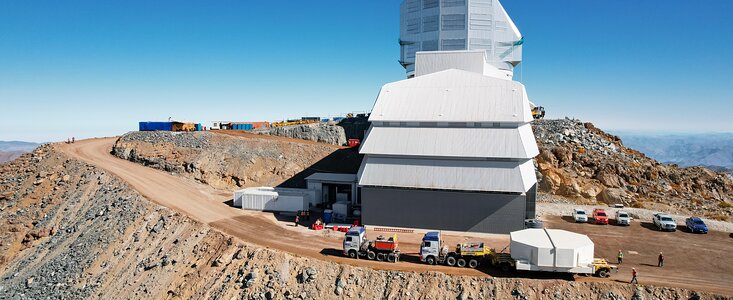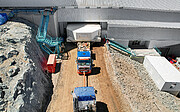Rubin’s 8.4-meter Mirror Moves Into the Observatory
Rubin Observatory’s primary/tertiary mirror has successfully moved from its storage building into the main observatory
12 March 2024
Vera C. Rubin Observatory’s 8.4-meter combined primary-tertiary mirror is officially home after being moved to the main observatory’s maintenance floor, where it will remain for the rest of the construction phase and throughout Rubin’s ten-year Legacy Survey of Space and Time.
The mirror, which is still an uncoated glass blank, arrived on Cerro Pachón, the mountain in Chile where the observatory is located, in May 2019. Since then it’s been safely packed in a transport box and stored in a building outside the observatory. On 7 March the summit team loaded that box onto a specialized truck to make the short, but important, 600-meter (650-yard) journey from the storage building to the observatory.
That wasn’t the only major move on the summit that week. To make room for the glass mirror in the observatory, the transport team first had to remove the 8.4-meter steel stand-in mirror. The successful transport of the steel surrogate on 6 March was a test run, done in reverse, for the glass mirror move the next day.
The success of both moves is thanks to the transportation company Javier Cortes, which also transported the mirror from the shipping dock in Coquimbo to the summit, as well as to Rubin’s Summit Safety team.
Although it only took two days to complete the mirror moves, many months of planning and site preparation were necessary to ensure a smooth ride for the delicate glass mirror. Some extra strategizing was also needed on the crowded observatory maintenance floor. In order to fit the mirror box onto the observatory floor, the mirror’s steel support structure was temporarily placed in the vertical platform lift, or equipment elevator. On-site Rubin staff members likened it to playing Tetris with big, oddly shaped blocks.
Now that the mirror has safely arrived inside the observatory the next step is to remove it from its storage box using a custom-made vacuum lifting fixture. It will then be prepared for coating in Rubin’s on-site coating chamber.
Rubin Observatory will begin science operations in late 2025. Rubin Observatory is a Program of NSF’s NOIRLab, which, along with SLAC National Accelerator Laboratory, will cooperatively operate Rubin.
More information
NSF’s NOIRLab (National Optical-Infrared Astronomy Research Laboratory), the US center for ground-based optical-infrared astronomy, operates the International Gemini Observatory (a facility of NSF, NRC–Canada, ANID–Chile, MCTIC–Brazil, MINCyT–Argentina, and KASI–Republic of Korea), Kitt Peak National Observatory (KPNO), Cerro Tololo Inter-American Observatory (CTIO), the Community Science and Data Center (CSDC), and Vera C. Rubin Observatory (operated in cooperation with the Department of Energy’s SLAC National Accelerator Laboratory). It is managed by the Association of Universities for Research in Astronomy (AURA) under a cooperative agreement with NSF and is headquartered in Tucson, Arizona. The astronomical community is honored to have the opportunity to conduct astronomical research on Iolkam Du’ag (Kitt Peak) in Arizona, on Maunakea in Hawai‘i, and on Cerro Tololo and Cerro Pachón in Chile. We recognize and acknowledge the very significant cultural role and reverence that these sites have to the Tohono O’odham Nation, to the Native Hawaiian community, and to the local communities in Chile, respectively.
Links
- Vera C. Rubin Observatory website
- Vera C. Rubin Observatory images
- More Rubin images
- Rubin videos
- Rubin multimedia resources
Contacts
Kristen Metzger
Communications Manager for Education and Public Outreach
Rubin Observatory
Email: kristen.metzger@noirlab.edu
Josie Fenske
Jr. Public Information Officer
NSF’s NOIRLab
Email: josie.fenske@noirlab.edu




